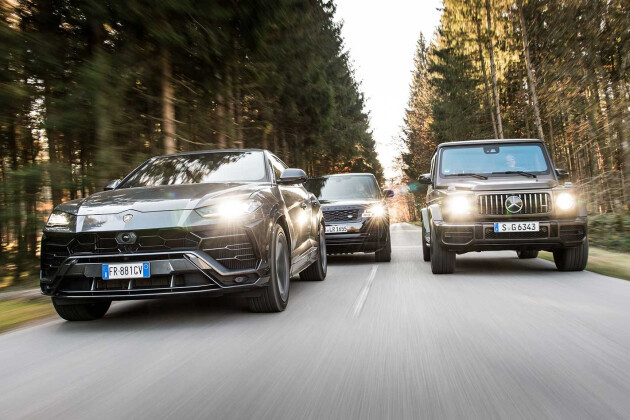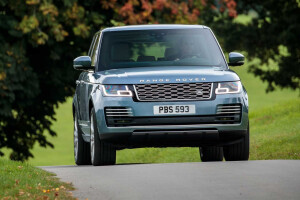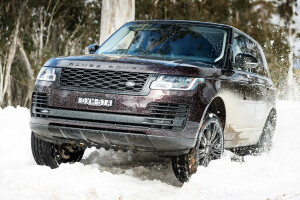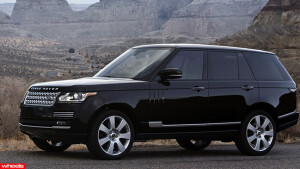Latest Review

2019 Lamborghini Urus vs Mercedes-AMG G63 vs Range Rover performance comparison review
Mega mumbo and physics-defying dynamics cloaked in a popular, luxe SUV body. Is this the future of ‘daily’ performance?
Status symbols don’t come much brasher or unique than these three performance SUVs. Each contender garners both looks of desire and disdain in seemingly equal measures. Bystanders either love them, or love to hate them – there’s no in-between. When it comes to cars, social acceptance is indeed a very fickle thing.
However, the new kid-carriers from Lamborghini and Mercedes-AMG, combined with a staid Brit in the Range Rover, are just as unique to each other as they are polarising to the public. We’re still getting our heads around the fact that Lamborghini is now offering an SUV – one sans natural aspiration nor a cylinder count more than eight.
The G63 simply shouldn’t exist, but we’re oh-so glad it does. It’s hilarious and rapid in equal measures and, now with some tweaks, not so rudimentary on-road. The RR Autobiography might be down on outright performance on paper, but it adds a layer of luxury the others can’t quite match.
Despite intensifying emissions debates and stricter laws, these inefficient, over-powered high-end SUVs barrel down the road on their over-sized alloy and strictly road-biased tyres. However, there’s got to be a reason why the $400K-plus Urus is sold out through to early 2020, why the G63 AMG accounts for the majority of G-Class sales and why the Rangie has, for some 38 years, been the darling of city slickers and the landed gentry. It’s a high-stakes game of fascination, frivolity and failure. Just maybe there’s something to this fast-SUV caper after all.
Lamborghini, the traditional maker of crazy supercars, received flak for releasing a $390,000 SUV. Yet, it can reportedly lap the Nardo handling track in southern Italy in a time comparable to the Huracan.
And with a 4.0-litre twin-turbo V8, you can see why it isn’t hanging about. Still, 2200kg is a lot of top-heavy weight to manage. And despite all the idiosyncrasies, it’s impossible not to be smitten with the stylish Italo-German crossover and its butch, 306km/h five-door coupe silhouette.
Even when stationary, the brand-new, yet oh-so-familiar $247k Merc looks as intimidating as ever – it’s an unmistakable boxy design. However, new LED headlights and revised styling bring the old-school-cool G63 into a modern context. Plus, with a hulking twin-turbo eight and proper off-road hardware underneath, it professes a dual-purpose persona the loudest. You’ll literally hear it from miles away.
It might be the oldest of this trio, but the $269k Rangie remains an example of understated luxe with sledgehammer performance. The V8 diesel is a good option, too, but the supercharged 5.0-litre bent eight makes all the right noises. If you want your RR’s forced induction to be the belt-driven type and not from exhaust gasses (BMW-sourced twin-turbo V8s are mooted in the future), then you better get in now.
All three V8 engines here come from standardised parts bins. However, they’ve been treated by bespoke engineering departments before being shipped to production. The 386kW/625Nm 5.0-litre supercharged V8 in the RR is, as mentioned, kind of a last-of-the-line effort before JLR starts purchasing engines from Germany.
The 430kW/850Nm 4.0-litre twin-turbo V8 put together in Affalterbach is based on the one-displacement-fits-all unit also used in myriad other Benz products. The 478kW/850Nm twin-turbo V8 in the Urus is the highest specification of the VW Group’s 4.0-litre, which was developed by Porsche. Although it’s frustrating that Lamborghini didn’t opt for its atmo V10 or V12, both with glorious soundtracks.
Despite similar outputs and kerb weights, the three super SUVs are leagues apart in the way they perform. To put things into perspective, the Urus’s 305km/h top speed is just 14km/h slower than the base Huracan and its 0-100km/h time of 3.6sec is just 0.2sec slower.
At the other end of the scale, the Range Rover needs 5.4sec to get to 100km/h, but it will still crack on to 251km/h if required. The Merc is the heaviest here at 2485kg and the least slippery through the air (0.54Cd), but it blasts to 100km/h in 4.2sec and will reach 241km/h (with an optional driver’s pack).
Walking up to the Urus it looks short, low and compact in this company. However, it’s actually 112mm longer than the Range Rover while eclipsing the AMG by 239mm. In combination with the longest wheelbase you’d expect a tangible packaging advantage.
The reality is different, though, with the Lambo’s 616-litre boot losing out to the 900-litre Range Rover, while comfortably outclassing the 454-litre G-Class. All three ‘bush-bashing’ models should offer more rear legroom than they do, but only the long wheelbase RR does – at a price.
Boasting classy seats and expensive materials, the Lambo’s cabin design attempts to fuse the practicality of a daily-driven SUV with the flair of a proper sports car. Evidence of this can be seen with the Huracan-style instrument graphics, an A8-inspired infotainment system and the usual caged starter button flanked by numerous drive modes.
Due to the coupe-like roofline, the cabin does feel very hemmed-in and there’s a plethora of buttons and graphics-filled displays to look at. While the indulgence has been stepped up, it’s still an in-your-face design in keeping with two-door Lamborghinis. It’s certainly a match for the extroverted exterior.
Like every G-Wagen before it, the latest iteration needs to be mounted due to its raised ride height. Once inside, there’s a feeling of invincibility as the slab-sided doors cocoon you. The commanding driving position is complimented by captain’s chair visibility and an interior that’s taken notes from the S-Class and the new A-Class. Expensive surfaces clash masterfully with the cube-esque body. While the improved seats are a welcome addition, the lack of the latest MBUX infotainment is a clear sign that the G-Class is an odd mix of old and new.
The four air vents mimic the oddball headlamp design, but the steering-wheel controls are numerous and messy, the inner door handles are awkward to operate and the list of standard driver assistance systems is too short for a new model. Welcome remnants from the past are the in-dash push buttons that lock the three diffs (the one in the middle is now of the variable-rate multi-plate clutch kind) and the world’s loudest central locking system.
After the facelift, the Range Rover is now ergonomically on par with the complex competition, it has picked up a few new assistance systems on the way, and the redesigned seats are more comfortable.
Like the Lamborghini, there’s a plethora of screens. The two central displays are touch-sensitive; the upper display can be customised to house your most-used functions, while the lower screen is predominately for climate controls and driving modes. The Autobiography’s company here also offer barnstorming opulence, but they can’t quite match the stately Brit – it truly is a sanctuary high above the level of many in terms of social hierarchy.
However, facts, figures and plush cabins aside, it’s how this group performs in terms of dynamics and driver involvement that needs exploring. Each SUV offers up character-defining moments, ones that help convey their differing personalities. Starting up the Mercedes-AMG G63 in the smaller hours of the morning makes a new enemy at every cough of the twin-tube side exhausts.
Like most AMGs, the downsizing and switch to turbocharging hasn’t hampered the aural theatre – sense of occasion is high, here. It’s matched by the unrelenting turn of speed shown by the Lambo. Pulling away at full speed from an unassuming Corvette at a set of traffic lights brings a wry smile to the faces of those in sight.
However, in contrast, driving anywhere in a shiny black Range Rover makes a comparatively subtle statement of prosperity and good taste. Knowing there’s effortless clout underfoot is pleasing.
When it comes down to it, the Urus and the Benz leave a lasting impression dynamically. The AMG defies the laws of physics. It never gives up and keeps besting itself at its own game. Up to 180km/h, the relentless forward thrust never ceases to amaze. Even at higher speeds, kickdown makes the nine-speed automatic shift two or three gears so you can thunder on without losing momentum.
There’s instant response from the hot-vee turbos and the monstrous 850Nm pulls you out of corners at sports car pace. And, like every AMG product, the meanest SUV to wear the three-pointed star spits and spats on idle, roars to the 7000rpm redline and pops and cracks on the overrun… all in an almost 2.5-tonne SUV.
People might discard the Range Rover as being unexciting, a character devoid of extremes and excess. In this context, it’s neither the one onlookers flock to nor the fastest by the clock. Instead, it simply does its job – and well.
The supercharged eight was never a lesson in efficiency and refinement, but the progressive torque delivery underlines the S in the SUV acronym. Its run to maximum revs is both calming and involving. Its company here can reel in the horizon faster, but in line with their busier facades, they feel hectic and more agitated. The Rangie lets them pull away because it must, more so than because it can.
Even the Urus aims to cater for all occasions, dedicating three of six driving modes to going off-road. With the air suspension set to its tallest position, the dampers in soft and ESP in Corsa, the Lamborghini is a surprising king of the gravel road.
Lacking a height-adjustable chassis, the only terrain the G-Class dislikes is deep sand – so dunes are out of the question. Although it does have enormous spring travel and wheel articulation, a trick AWD system complete with a low-range transfer case and significant ground clearance, so the AMG isn’t shy when traversing the tough stuff.
The Range Rover has little to prove in terms of off-road credentials. The Autobiography is an expert in filtering, cushioning, isolating and distancing its users from the terrain it wafts over. It’s not one single talent that does the trick here as it’s more a blend of virtues and abilities. It has a cosseting balance of roll and ride, dive and yaw as well as stability and poise.
There’s an underlying flow that’s more concise and linear than ever. Just remember that it’s more Autobiography than SVR here, so don’t expect bolstering sway bars or lightning-fast steering responses.
We’ve established that the Urus is fast in a straight line, but in terms of handling, steering, braking and being fun to drive, it also scores massive points. It never ceases to surprise. Fitted with 440mm (front) and 370mm rear carbon-ceramic brake discs (hidden behind 22-inch wheels and soft rubber), the braking power is more than a match for the 2.2-tonne weight and epic speed – it’s like a jet engine in reverse.
It’s insane how late you can brake, with the grippy rubber biting into the tarmac. Even with the stoppers in full force, early turn-in is welcomed thanks to the ample grip. Yes, there is some understeer, but it’s nothing a momentary flick of the steering wheel or lift off the throttle can’t fix. Assisting from behind the scenes are torque vectoring, the subtle but effective rear-wheel steering and active sway-bars.
Insanity is also a term that comes to mind when piloting the ultimate G-Class. Originally conceived by order of several European armies as go-anywhere anti-Jeep, the latest iteration of the ladder-frame icon born in 1979 is the professed darling of the global nouveau riche.
The AMG puts on a show as soon as you give it some stick, squirming out of sight and out of earshot in no time at all. Launching from a standstill causes the nose to lift starkly and the directional stability depends on the quality of the surface underneath.
While the shoebox-like aerodynamics help to reduce the stopping distance at speed, there is no real remedy for the high centre of gravity. Even in Sport mode, the adaptive dampers can’t deliver inspiring road manners. The steering firms up during brisk changes of direction and the ride quality is okay, but far from brilliant, while the ESP light flashes as soon as you start putting the foot down.
Jump in the RR and a stark shift in mindset is required. There is, of course, plenty of grunt to play with and the cushy ride, mixed with impeccable levels of sound suppression, results in an exquisite driver environment.
The Range Rover is without a doubt the luxury GT of the SUV guild, all the while being less ostentatious than a Bentley Bentayga or Rolls-Royce Cullinan, yet still having a tailored level of atmosphere and ambience. It invented the segment, and it still owns a good part of it. It really can do both town and country or short trips and long hauls. However, it has been around for a while – and it shows. Others brake better, steer with more precision, are less vague at the limit and are just more fun to drive.
Perspective always seems to colour judgement, but if you must have an SUV with the soul of a sports car, take the Lambo. If you’re after a head-turner with a retro look and contemporary engineering, then the G63 will be your cup of tea. However, the oldie but goodie from Solihull is the upper-crust, go-fast SUV to go for if you want the best all-rounder. Ultimately, it’s all about personal preference and there’s no true loser here because while all three’s reason for being might be tenuous and fickle, we’re still glad they exist.
Fast Facts
| Mercedes-AMG G63 | Range Rover Autobiography 5.0 SC | Lamborghini Urus | |
| Body | 5-door, 5-seat SUV | 5-door, 4-seat SUV | |
| Drive | all-wheel | ||
| Engine | 3982cc V8, DOHC, 32v, twin-turbo | 5000cc V8, DOHC, 32v, supercharged | 3996cc V8, DOHC, 32v, twin-turbo |
| Bore x Stroke | 83.0 x 92.0mm | 92.5 x 93.0mm | 86.0 x 86.0mm |
| Compression | 10.5:1 | 9.5:1 | 9.7:1 |
| Power | 430kW @ 6000rpm | 386kW @ 6000rpm | 478kW @ 6000rpm |
| Torque | 850Nm @ 2500-3500rpm | 625Nm @ 2500rpm | 850Nm @ 2250-4500rpm |
| Power/Weight | 173kW/tonne | 158kW/tonne | 218kW/tonne |
| Transmission | 9-speed automatic | 8-speed automatic | |
| Weight | 2485kg | 2450kg | 2197kg |
| Suspension (f) | multi-links, adaptive dampers, anti-roll bar | double wishbones, adaptive dampers, air springs | multi-links, adaptive air suspension w/ electromechanical active roll stabilisation |
| Suspension (r) | multi-links, adaptive dampers, anti-roll bar | multi-links, adaptive dampers, air springs | multi-links, adaptive air suspension w/ electromechanical active roll stabilisation |
| L/W/h | 4873/1984/1966mm | 5000/2073/1869mm | 5112/2016/1638mm |
| Wheelbase | 2890mm | 2922mm | 3003mm |
| Tracks | 1654mm (f/r) | 1693mm (f); 1685mm (r) | 1695mm (f); 1710mm (r) |
| Steering | electrically assisted rack-and-pinion | ||
| Brakes (f) | 400mm ventilated discs, 6-piston calipers | 380mm ventilated discs, 6-piston calipers | 440mm carbon-ceramic discs, 10-piston calipers |
| Brakes (r) | 370mm ventilated discs, single-piston calipers | 365mm ventilated discs, single-piston calipers | 370mm carbon-ceramic discs, 6-piston calipers |
| Wheels | 22.0 x 10.0-inch (f/r) | 21.0 x 9.0-inch (f/r) | 22.0 x 10.0-inch (f); 22.0 x 10.5-inch (r) |
| Tyres | Goodyear Eagle F1; 295/40 R22 (f/r) | Continental CrossContact; 275/45 R21 (f/r) | Pirelli P Zero; 285/40 R22 (f); 325/35 R22 (r) |
| Price | $247,329 | $268,900 | $390,000 |
| Pros | Newfound on-road ability; epic straight-line pace; sound; cabin | Balances performance and luxury best; effortless pace; quiet cabin | Dynamic benchmark... for an SUV; aggressive styling; very fast; badge |
| Cons | It’s still a 2.2-tonne shoebox dynamically; road manners | Lacks outright punch in this company; getting old; weight | It’s not cheap; polarising styling; where’s the atmo V10/V12? |
| Rating | 4 out of 5 stars | 4 out of 5 stars | 4 out of 5 stars |




.jpg)

